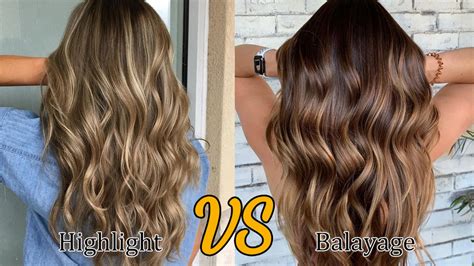The Ultimate Guide to Highlighting and Balayaging Your Hair
Highlight: A technique that uses foils to separate strands of hair and lighten them with bleach or color.

Balayage: A freehand painting technique that uses a paddle or brush to apply bleach or color to the hair, creating a natural, blended look.
Key Differences
- Foils vs. Freehand: Highlight uses foils, while balayage is freehand.
- Uniformity vs. Natural: Highlights create a more uniform color, while balayage results in a more natural, blended look.
- Durability: Highlights last longer than balayage due to the use of foils.
- Cost: Balayage generally costs more than highlights.
Pros and Cons
Highlights
Pros:
- Longer-lasting
- More precise and consistent
- Suitable for all hair types
Cons:
- Can damage hair due to the use of bleach
- Can create a “blocky” look
- More expensive than balayage
Balayage
Pros:
- Less damaging to hair
- Creates a more natural, blended look
- Less expensive than highlights
Cons:
- May not be suitable for all hair types
- Can require more maintenance
- Can be time-consuming
Which Technique is Right for You?
The best technique for you depends on your personal preferences and hair type.
- Highlights: Ideal for those who want a more uniform, high-contrast look.
- Balayage: Perfect for those who prefer a natural, blended look that requires less maintenance.
Creative New Word: “Bronde-Balayage”
Combine the techniques of balayage and hair lightening to create a warm, natural look. It involves painting blonde highlights on brown hair, creating a blended, sun-kissed effect.
Top 6 Tips for Choosing a Highlight or Balayage Color
- Consider your skin tone and eye color.
- Look for inspiration online or in magazines.
- Consult with a professional hair stylist for personalized advice.
- Start with a lighter shade and gradually add more color.
- Use a color-protecting shampoo and conditioner.
- Get regular trims to remove split ends and keep your color looking fresh.
Comprehensive Tables
Table 1: Highlights vs. Balayage – Key Differences
| Feature | Highlights | Balayage |
|---|---|---|
| Separation | Foils | Freehand |
| Color | Uniform | Blended |
| Durability | Longer-lasting | Less durable |
| Cost | More expensive | Less expensive |
Table 2: Pros and Cons of Highlights
| Pros | Cons |
|---|---|
| Longer-lasting | Can damage hair |
| More precise | Can create a blocky look |
| Suitable for all hair types | More expensive than balayage |
Table 3: Pros and Cons of Balayage
| Pros | Cons |
|---|---|
| Less damaging to hair | May not be suitable for all hair types |
| Creates a natural, blended look | Can require more maintenance |
| Less expensive than highlights | Can be time-consuming |
Table 4: Top 5 Hair Types Suitable for Balayage
| Hair Type | Benefits |
|---|---|
| Fine hair | Adds volume and depth |
| Thick hair | Lightens strands without creating a brassy tone |
| Curly hair | Enhances curls and reduces frizz |
| Straight hair | Creates a subtle, sun-kissed effect |
| Long hair | Highlights layers and creates a gradient look |
Frequently Asked Questions
1. Can I highlight and balayage my hair at the same time?
Yes, this technique is known as “ombre balayage” and creates a gradual transition from dark roots to lighter ends.
2. How often should I get highlights or balayage?
Every 6-8 weeks for highlights and every 3-4 months for balayage, depending on hair growth and fading.
3. Can balayage be used to cover gray hair?
Yes, but it may require multiple sessions and additional color touch-ups.
4. Can highlights damage my hair?
Yes, bleaching and highlighting can damage hair, especially if done incorrectly.
5. How can I protect my highlighted or balayaged hair?
Use color-protecting products, avoid excessive heat styling, and get regular trims.
6. Can I do balayage at home?
It is recommended to consult with a professional hair stylist for balayage, as it requires specialized skills and techniques.
